
Każdy sport ma swoje charakterystyczne elementy. Nie inaczej jest w przypadku cheerleadingu, gdzie możemy wymienić wiele elementów jak: energia, cheer muzyka, skoki, a także arm motion, czyli charakterystyczne ustawienia rąk.
Dla cheerleadingu arm motion, są jak dla tańca klasycznego pozycje rąk i nóg. Są charakterystyczne, dokładnie opisane i w zasadzie od nich zaczynamy przygodę w cheer świecie.
To, co jeszcze jest typowe dla naszych arm motion, to, że są one bardzo mocne- mają wyglądać bardzo sportowo- a zatem w przeciwieństwie do tańca klasycznego, nie ma tu mowy o jakiejkolwiek delikatności. Ręce są cały czas mocno napięte i w zasadzie nie ma momentu, kiedy są rozluźnione.
Jak prawidłowo wykonywać arm motion- ustawienia rąk
Przede wszystkim należy poznać prawidłowe ustawienia. Każde z tych ustawień nie tylko ma swoją nazwę- głównie angielską, ale także zasady wykonania.
Pierwszą zasadą jest to, że ustawienia rąk głównie wykonywane są przed płaszczyzną czołową, czyli ręce wysunięte są lekko do przodu, jakby przed naszym ciałem. Zwróć uwagę, że napisaliśmy “głównie”, czyli nie wszystkie, a wokół kilku ustawień toczy się aktywny spór. To, że zatrzymujemy ręce w konkretnych pozycjach odróżnia cheerleading np. od disco, gdzie używa się pełnych zakresów stawów.
Druga zasada mówi, że jeśli danego ustawienia nie wykonujemy przed płaszczyzną czołową, to stosujemy znaną w cheerleadingu zasadę “staw nad stawem” lub “staw za stawem”. Utrzymanie tej zasady gwarantuje, że każdy wykona dane ustawienie dokładnie w ten sposób. Najlepszym przykładem jest ustawienie High Touchdown, gdzie ręce skierowane są ku górze. Gdzie jest tutaj zasada “staw nad stawem”? Otóż nadgarstki są dokładnie nad łokciami, a łokcie nad barkami. To gwarantuje nam, że każdy zawodnik będzie miał tak samo ustawione ręce. Pamiętajmy, że w cheerleading jeśli cała drużyna robi to samo, to wszyscy muszą to wykonać w dokładnie ten sam sposób.
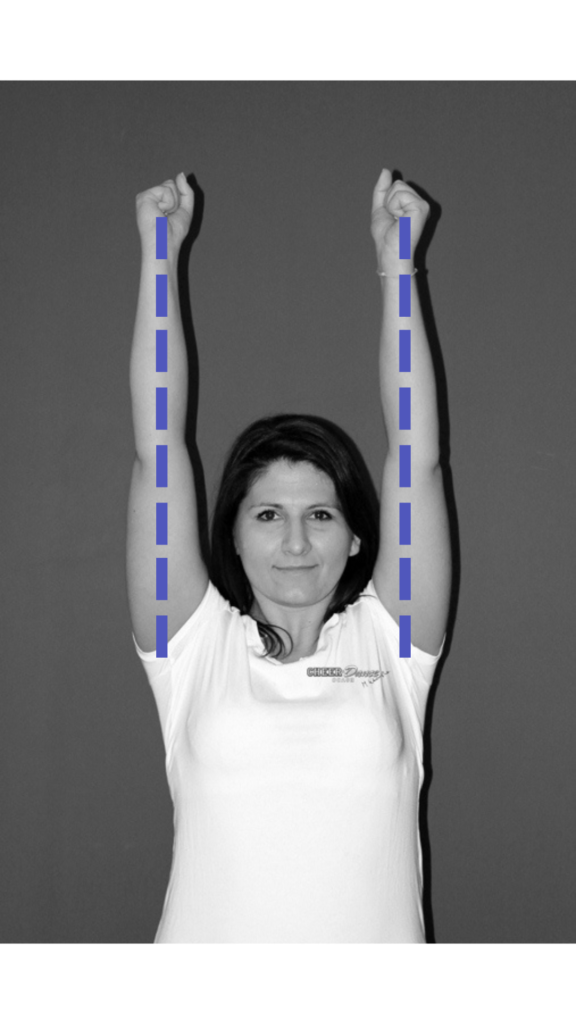
Trzecia zasada mówi, że ręce kontrolujemy nie tylko od ramion do palców, ale od łopatek do przestrzeń jeszcze “za palcami”- czyli dalej niż kończą nam się dłonie. Co więcej, łopatki są skierowanie w dwóch kierunkach: w stronę kręgosłupa, a także w dół. Utrzymanie prawidłowej pozycji łopatek zagwarantuje nam perfekcyjnie proste plecy. Powiedzenie, że kontrolujemy ręce jeszcze dalej niż kończą się palce, daje nam pełną kontrolę nad całymi rękami, dzięki czemu są one silne i energiczne.
Do czego używamy arm motion w cheerleadingu?
Arm motion wykorzystujemy zarówno w perfomance cheer (kategorie taneczne), a także w cheerleadingu akrobatycznym. Pomagają one ujednolicić ruch poszczególnych osób w kwestiach tanecznych, a także dodają jeszcze bardziej cheer charakteru w stuntach i piramidach. Z naszych obserwacji wynika, że najbardziej popularnymi ustawieniami rąk są High V i Punch.
We freestyle pom musimy tworzyć, co chwilę, nowe ustawienia z pomponów. I nie mam tutaj na myśli obrazków typu “serduszko”, czy “kółko”. W cheerleadingu raczej takich rzeczy się nie praktykuje. Mam na myśli ustawienia pomponów, dzięki wykorzystanych arm motion. To właśnie one pomagają w cheer stylu uzyskać spójność na parkiecie. Zasadniczo, co beat w muzyce powinno pojawić się nowe ustawienie. Jest to teoria i często w grupach dziecięcych lub początkujących może być to trudne. Dlatego pamiętajmy, że lepiej jest uprościć choreografię rąk, aby zawodnicy mogli ją wykonać dynamicznie i precyzyjnie.
Zmiany arm motion są szybkie, dynamiczne i precyzyjne
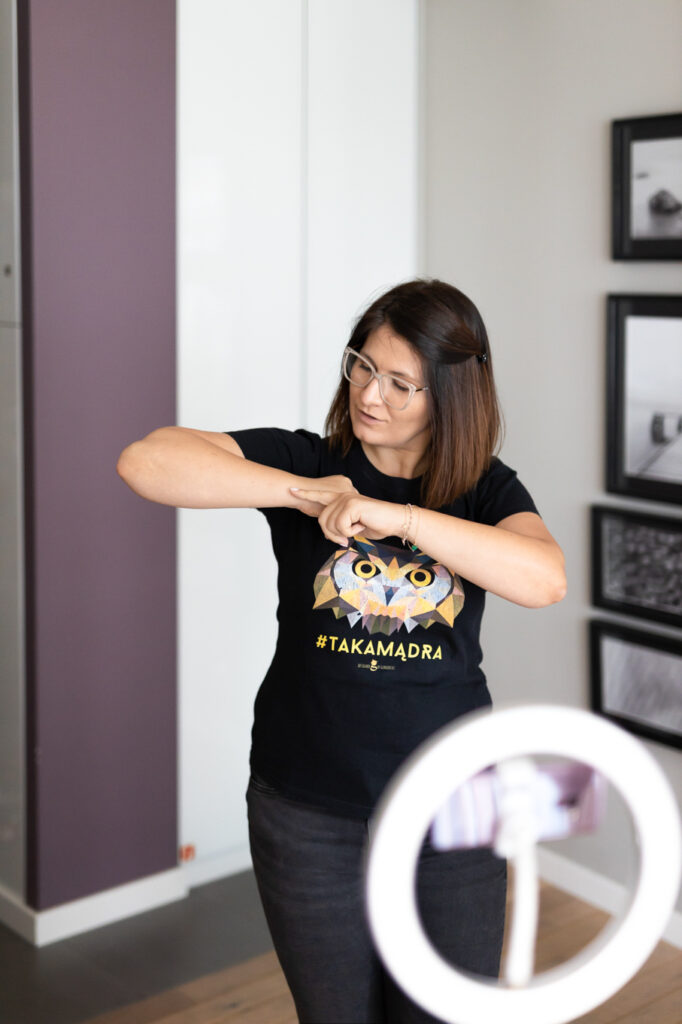
Porozmawiajmy teraz o dynamice i szybkości zmian ustawień rąk. To, co jest charakterystyczne dla cheerleadingu to pewnego rodzaju dynamika, a także umiejętność bardzo dużej kontroli własnego ciała. To właśnie ta kontrola i zatrzymania w choreografii sprawiają, że dla niektórych choreografie cheer są odbierane jako dość “robotyczne”. Od płynności ruchów mamy cheer jazz 🙂
Umiejętność zatrzymania rąk w konkretnym miejscu, przy bardzo dużej ich szybkości wcale nie jest takie łatwe. Aby osiągnąć umiejętność zatrzymania ręki w konkretnym ustawieniu, musimy ćwiczyć mięśnie wykonujący dany ruch, ale i mięśnie przeciwstawne, aby ten ruch zatrzymać.
Jak wykorzystać arm motion w choreografii?
Jak wspomniano wcześniej arm motion nadają cheer charakteru choreografiom. Zasadą jest, że jeżeli dany układ wygląda dobrze bez pomponów, to nie jest to choreografia freestyle pom. Freestyle pom wygląda dobrze wyłącznie przy użyciu pomponów.
Gdzie użyć arm motion? Zasadniczo, to w całej choreografii. Zaawansowane zespoły zmieniają ustawienia rąk nawet podczas kręcenia piruetów. W zespołach mniej zaawansowanych lub kiedy chcemy dać trochę oddechu drużynie w choreografii, wykorzystajmy dużo ustawień rąk np. w marszowym przejściu. Wtedy sam marsz nie przykuje bardzo uwagi widza, tylko kreatywne ustawienia z pomponami.
Kreatywne arm motion- pomysłowe ustawienia rąk
Jak kreatywnie używac arm motion? Przede wszystkim poznaj je wszystkie. Nie ograniczaj się tylko do tych najbardziej popularnych. Oczywiście, mierz siły na zamiary. Jeśli Twoja drużyna dopiero się ich uczy, to na spokojnie zacznij od tych najbardziej popularnych i symetrycznych.
Pamiętaj, że szukamy komplementarnych ustawień pomponów w całej drużynie. Dlatego wykorzystaj różne położenie poszczególnych zawodników. Niech boczne sektory ustawień wykonają arm motion z wysunięciem na boki, a centrum niech zrobi jedno z wielu symetrycznych arm motion. Pamiętaj, dążymy do tego, aby cała drużyna tworzyła jedno, spójne i kreatywne ustawienie.
Jeśli nie masz wielu pomysłów na drużynowe ustawienia, użyj tych samych arm motion, ale na różnych poziomach!
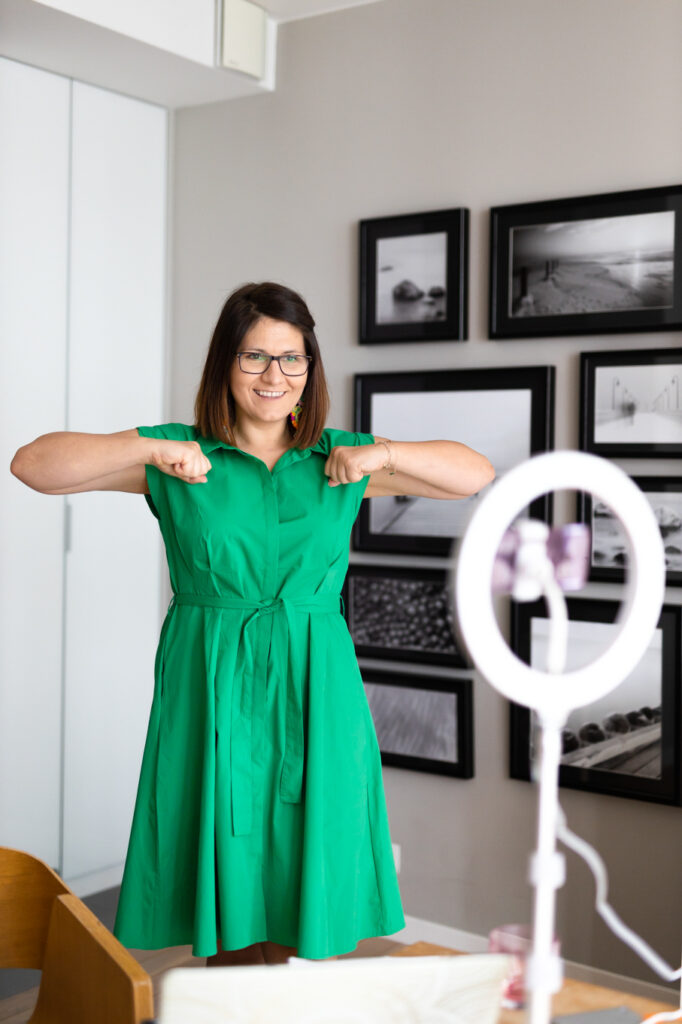
Baw się rytmem i zatrzymuj drużynę na akcenty w muzyce. Wykorzystaj synkopę! Synkopa to jest to “i” pomiędzy uderzeniami w muzyce. Jeśli masz silną drużynę, to z pewnością dacie radę. Jednak pamiętaj, aby nie przesadzać- wracamy do zasady, że lepiej zatańczyć prostszą choreografię, ale zrobić to z energią i siłą niż nie nadążać za rytmem.
Brak Ci pomysłów? Podziel arm motion!

Czy wiesz, że każde ustawienie możesz podzielić? Jeśli nie masz pomysłu na nowe ustawienie wybierz położenie prawej ręki z jednego arm motion, a położenie lewej z innego ustawienia! Zdziwisz się jak bardzo to jest proste!
Możesz zainspirować się jednym filmem, gdzie trenerzy podczas webinaru z Małgorzatą Wrońską ułożyli, a potem nagrali wspólny film <oglądam>.
Szkolimy również z arm motion- figury cheer
Podczas szkoleń trenerskich arm motion stanowią kilkugodzinny blok. Dlaczego? Ponieważ dzięki nim choreografie z pomponami wyglądają jak kategorie turniejowe. Zajęcia cheer rekreacyjne nie są obarczone takimi wymaganiami jak starty w turniejach.
Zawsze kładziemy duży nacisk na podstawy- to od nich wszystko się zaczyna. Uczymy jak nauczyć prawidłowych ustawień, a także pokazujemy sporo gier i zabaw, które pomogą zawodnikom zapamiętać każde z nich.
Dodatkowo pokazujemy także jak ćwiczyć, aby wzmocnić mięśnie, które wykonują dany ruch, a także te które go hamują. Arm motion to nie jest temat, który należy uznać za łatwy i potraktować go po macoszemu.
Potrzebujesz szkolenia? Wypełnij forumlarz!
Podstawowe ustawienia rąk w cheerleadingu
Poniżej przedstawiamy Wam kilka najpopularniejszych ustawień rąk. Nie są to wszystkie, ale te, które uważamy za najbardziej przydatne na sam początek 🙂
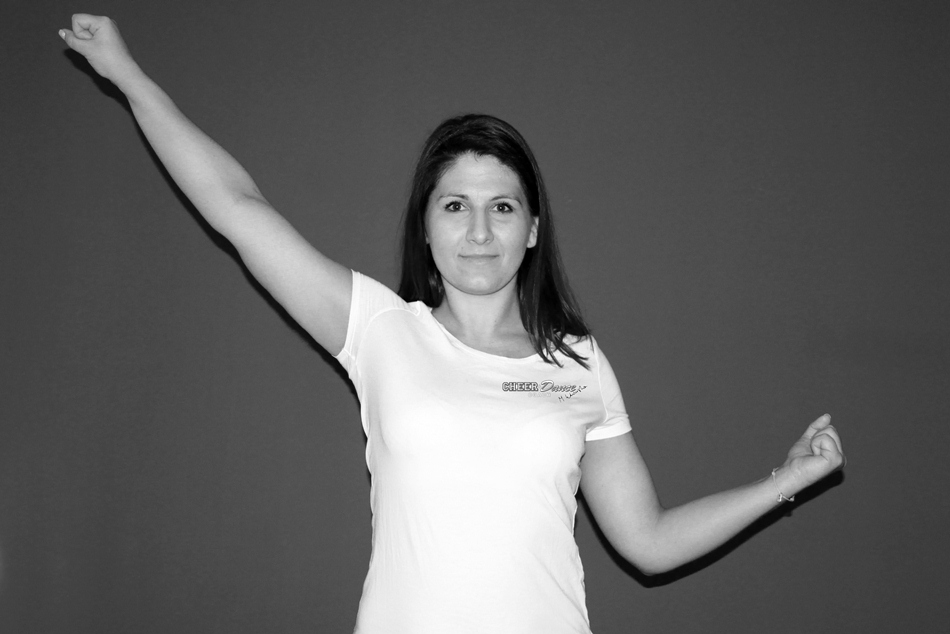
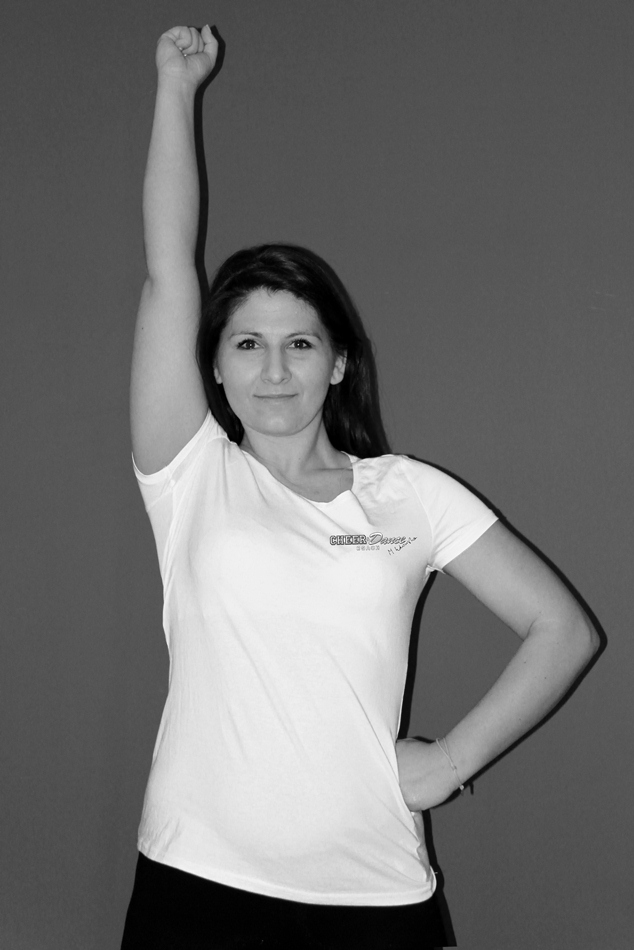
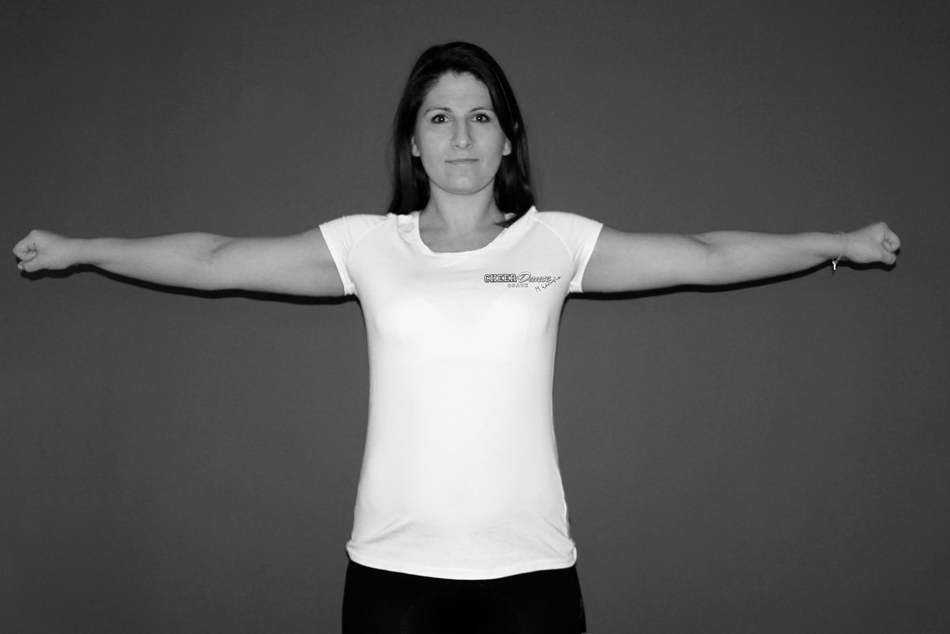
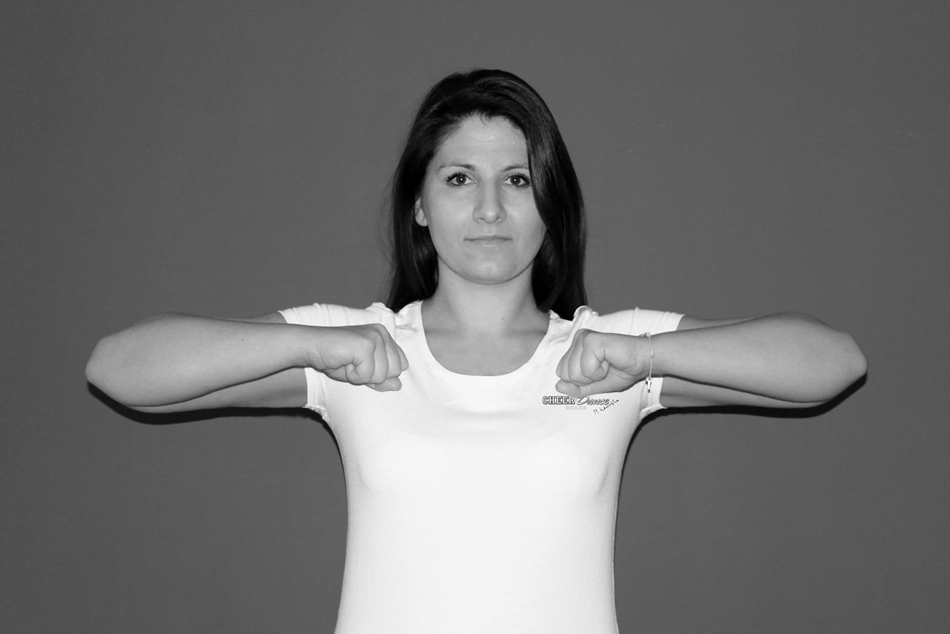
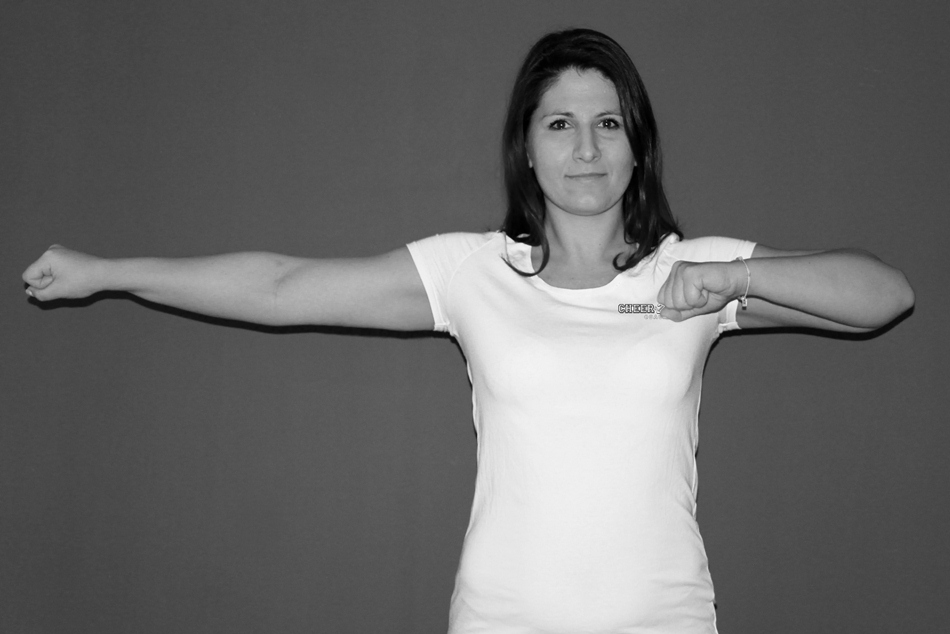
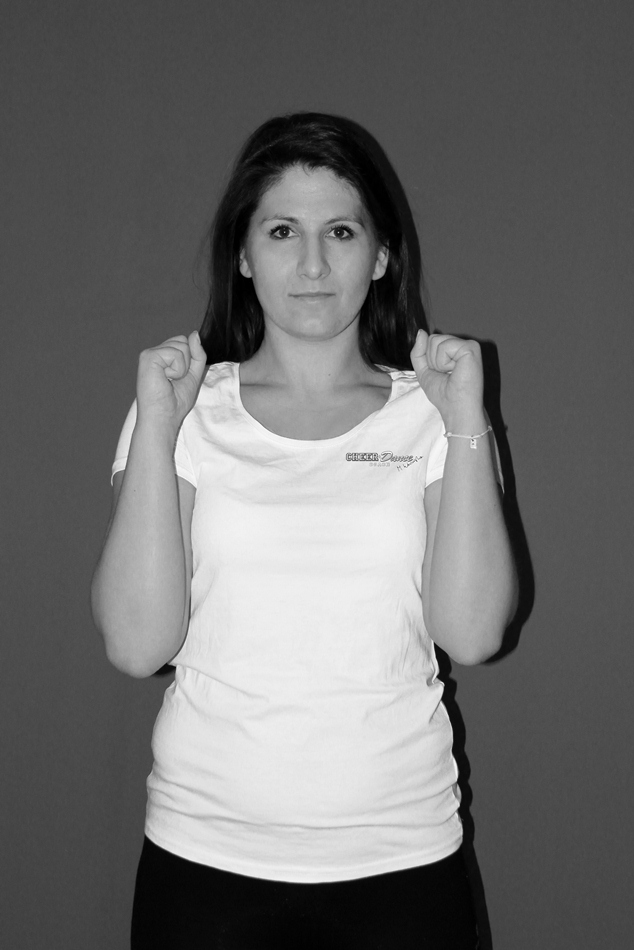
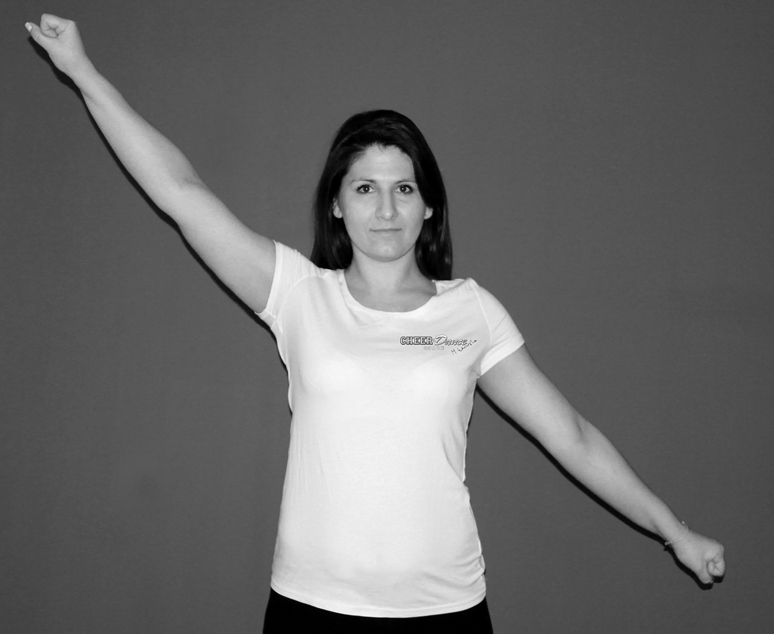

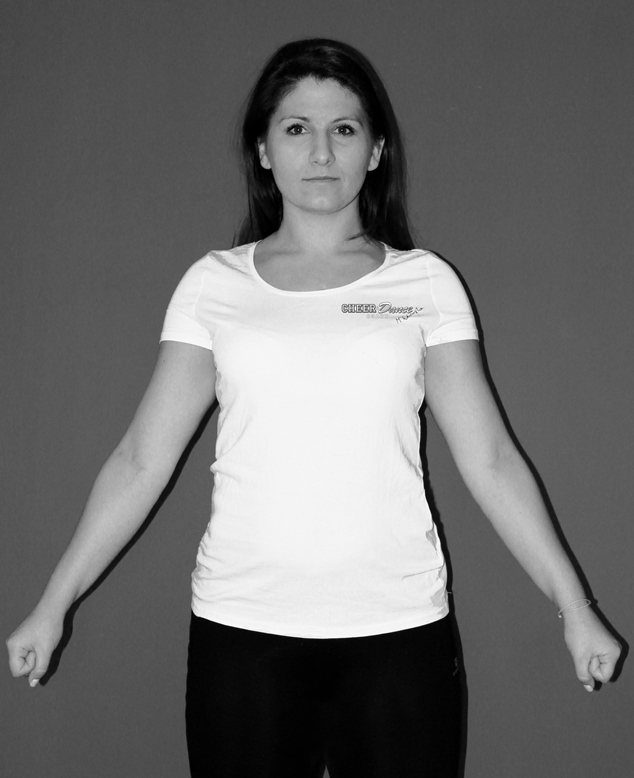
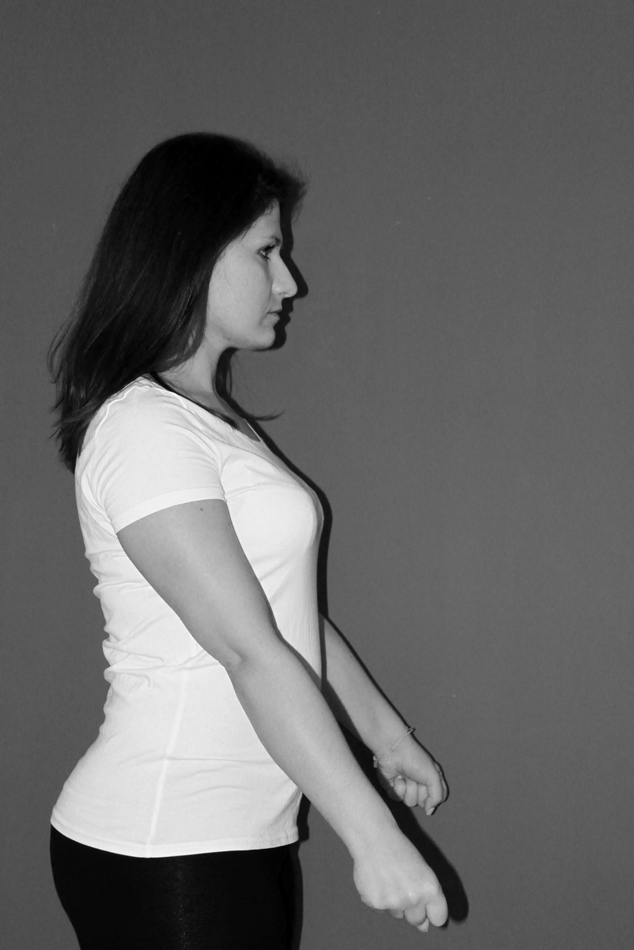
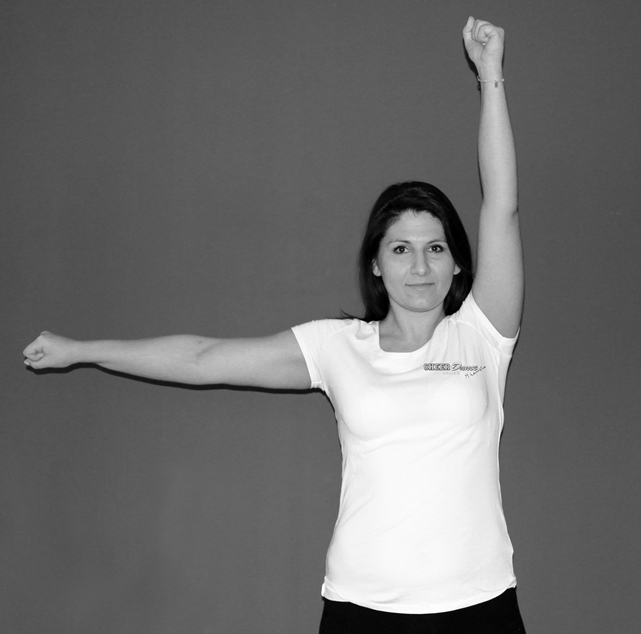
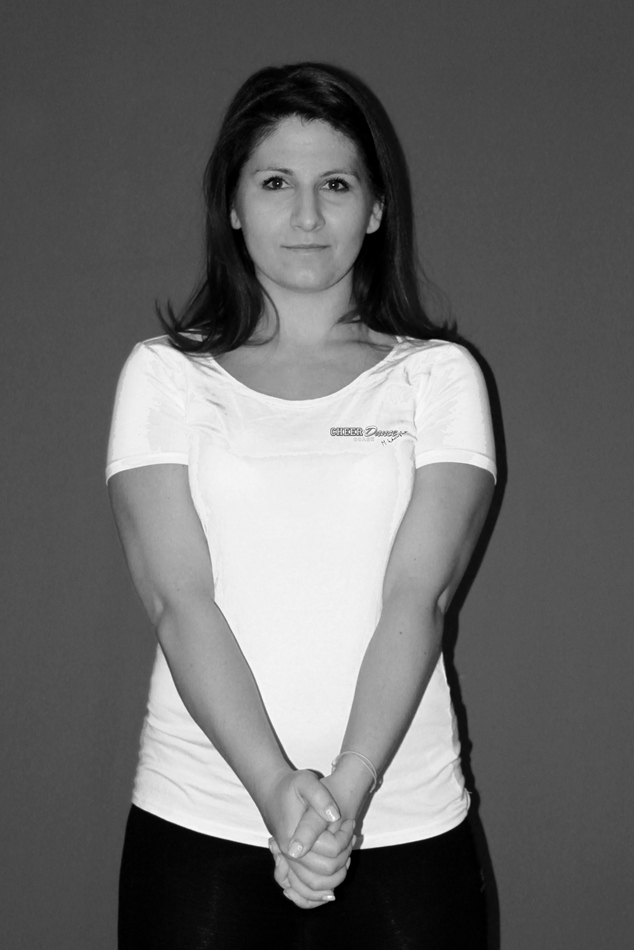
Pom Motions in cheerleading

Every sport has its own characteristic elements. It is no different for cheerleading, where we can mention many elements like energy, cheer music, jumps, and arm motions.
For cheerleading arm motions, are like for classical dance arm and leg positions. They are distinctive, accurately described, and basically from them we start our adventure in the cheer world.
What else is typical of our arm motion? They are very strong – they are supposed to look very sporty, sharp and dynamic – and therefore, unlike classical dance, there is no place of any softness. The arm are tight all the time and there is basically no moment when they are relaxed.
How to properly perform arm motion
First of all, you need to know the correct placement. Each of these settings not only has its own name-mainly English-but also has rules of execution.
The first rule is that arm motions are mostly performed in front of the frontal plane, that is, the arms are shifted slightly forward.Note that we wrote “mostly,” meaning not all, and there is an active dispute around several positions like “T”. The fact that we stop our arms in specific positions distinguishes cheerleading from disco, for example, where full joint ranges are used.
How to properly perform arm motion- hand settings
You need to know the correct placement.
The next rule is that if a particular placemnt is not performed in front of the frontal plane, we use the “joint over joint” or “joint behind joint” rule, which is well-known in cheerleading. Maintaining this rule ensures that everyone performs a given alignment exactly this way.
The best example is the High Touchdown position, where the arms point upward. Where is the “joint over joint” rule here? Well, the wrists are exactly above the elbows and the elbows are above the shoulders. This guarantees us that every athlete will have the same positioning of the hands. Let’s remember that in cheerleading if the whole team is doing the same thing, everyone must perform it in exactly the same way. We are looking for the unifirmity.
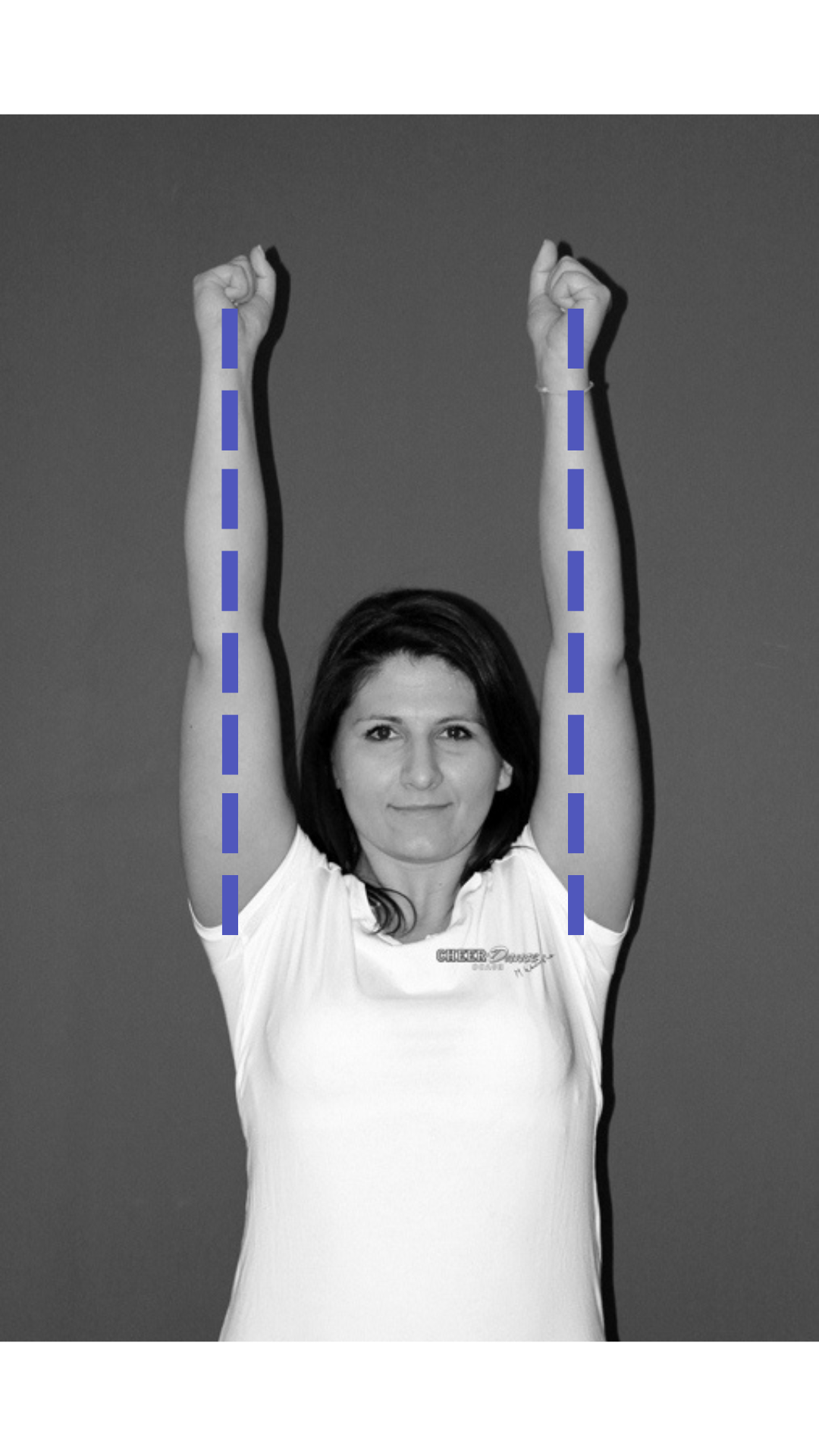
The third rule is, that we control the arms not only from the shoulders to the fingers, but from the shoulder blades to the space still “behind the fingers”-that is, further than the end of our hands. What’s more, the shoulder blades are pointed in two directions: toward the spine, and also downward. Maintaining the correct position of the shoulder blades will guarantee us a perfectly straight back. Saying that we control our hands even farther than our fingers end gives us full control over our entire hands, making them strong and energetic.
Creative arm motion- imaginative arm settings
How to use arm motion creatively? First of all, get to know them all. Do not limit yourself to only the most popular ones. Of course, measure your strength against your strength. If your team is just learning them, start with the most popular and symmetrical ones.
Remember that we are looking also for big pictures with pom, whith using different pom positions.. Example? Let the side sectors of the formations do arm motion with extension to the sides, and let the center do one of the many symmetrical arm motions. Use levels! Remember, you are aiming for the whole team to form a single, cohesive and creative setting.
If you don’t have many ideas for team pom pictures, use the same arm motion, but at different levels!
Play with the rhythm and stop the team for accents in the music. Take advantage of syncopation! Syncopation is the “and” between beats in music. If you have a strong team, you can certainly do it. However, remember not to overdo it – we are back to the principle that it is better to perform a simpler choreography, but with an energy and strength than not to keep up with the rhythm.
Do you lack ideas? Split the arm motion!

Did you know that you can split any setting? If you don’t have an idea for a new setting, choose the position of the right arm from one arm motion, and the position of the left arm from another setting! You’ll be surprised how easy it is!
You can get inspired by one video, where coaches during a webinar with Malgorzata Wronska arranged and then recorded a joint video .
We also train with arm motion
During coaching courses, arm motion make up a block of several hours. Why? Because we make choreographies with poms! Recreational cheer classes are not burdened with such requirements as competitive cheerleading classes..
We always put a lot of emphasis on the basics – it’s where it all starts. We teach how to teach proper placement, as well as show a lot of games that will help athletes remember each position.
In addition, we also show how to practice to strengthen the muscles that perform the movement, as well as those that inhibit it. Arm motion is not a subject that should be considered easy and taken lightly.
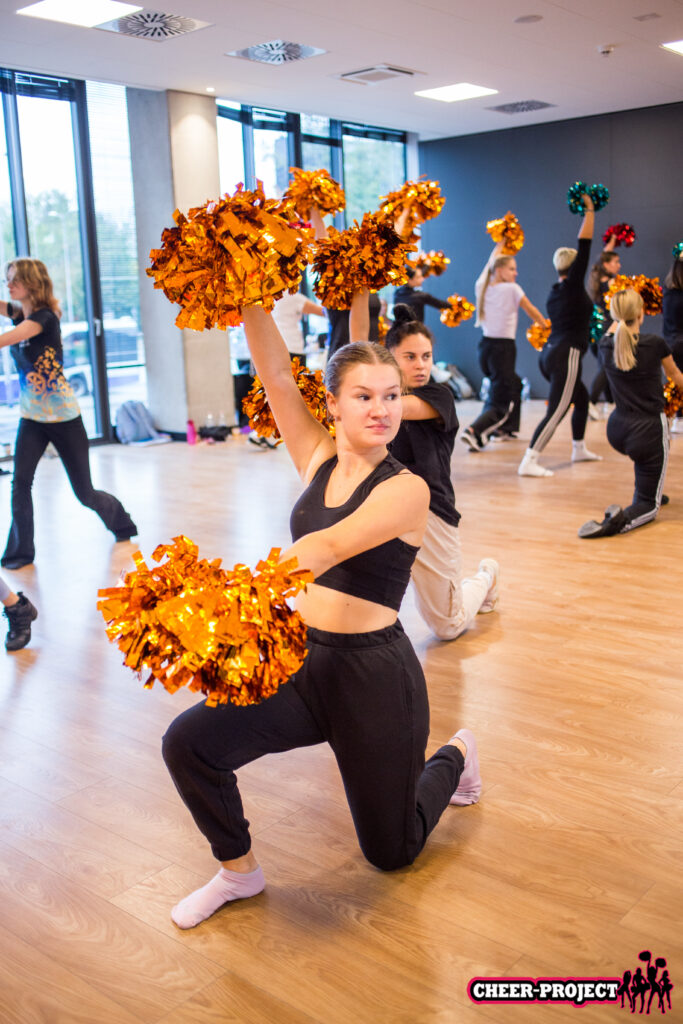
Need some help with those or the full choreo? Text us! Would be happy to help!
Let’s start with some basic
Here, you may see the most basic arm motion. We all start from somewhere, so don’t be affraid of basics!














